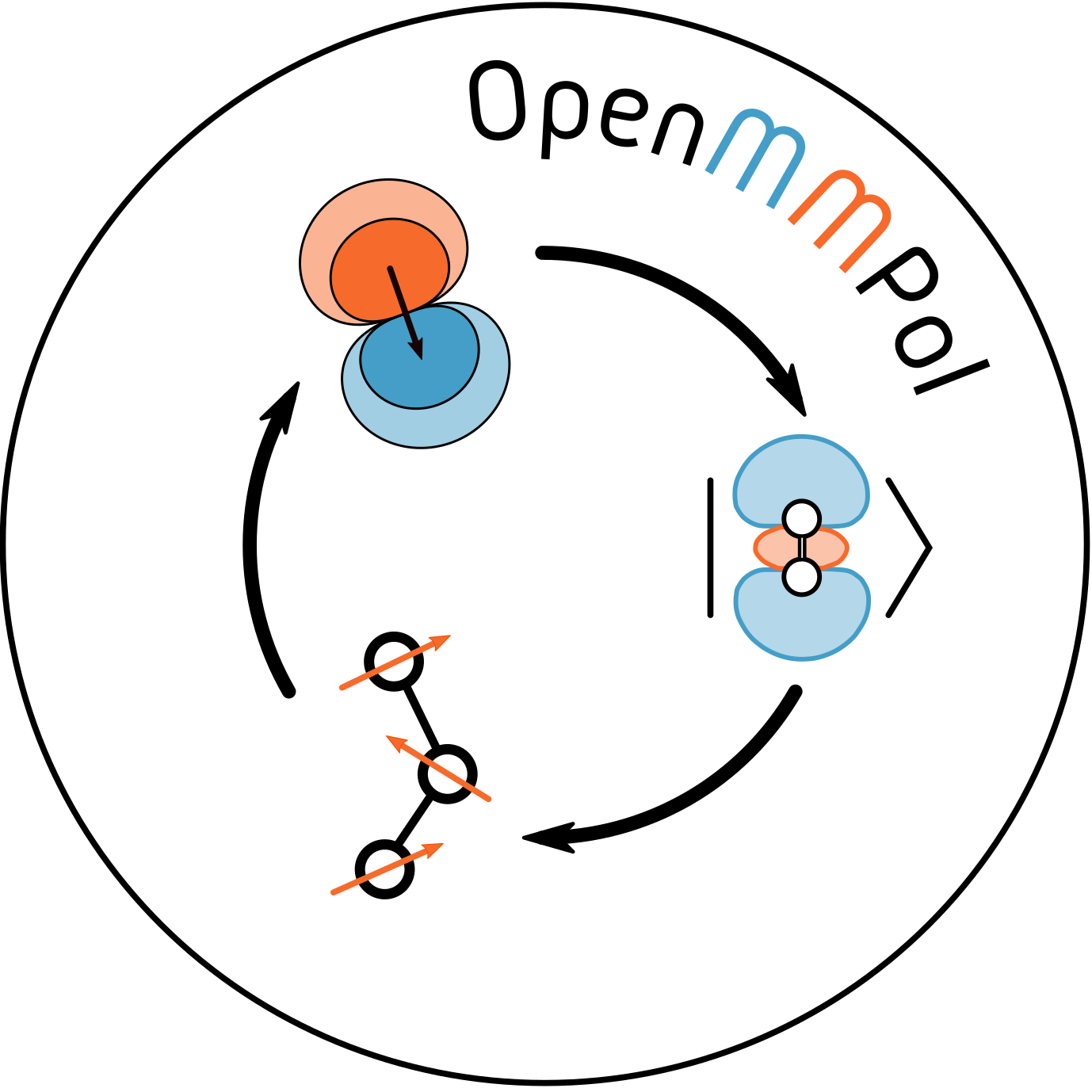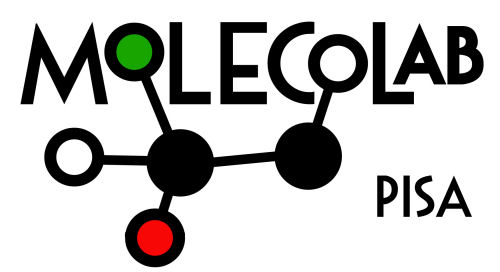An open-source implementation of induced point-dipole polarizable embedding

What is OpenMMPol
OpenMMPol is an open-source library to interface quantum chemical software with atomistic polarizable embedding. With OpenMMPol any quantum mechanical method that is able to provide the electrostatic potential, field, and field gradient for a given electronic density could be coupled to polarizable embedding with AMOEBA (and other forcefield). Through simple interface functions, it allows to compute the QM/AMOEBA contribution to the energy and to the selected Hamiltonian.
OpenMMPol also implements all the non-electrostatic terms of the MM force field (Van der Waals and bonded interactions). This allows the host code to compute the full potential for the embedded system.
OpenMMPol is written in Fortran and is distributed with interfaces to C, Fortran and Python3.
OpenMMPol is written and maintained by the MoLECoLab (Modeling Light & Environment in Complex Systems) research group at the University of Pisa (molecolab.dcci.unipi.it).
License
OpenMMPol is free software, you can use it under the terms of the LGPL-3.0 License.
You can get the code here
You can get the documentation here
Please cite the following papers if you use the library:
● Polarizable embedding QM/MM: the future gold standard for complex (bio)systems?
M. Bondanza, M. Nottoli, L. Cupellini, F. Lipparini and B. Mennucci - Phys. Chem. Chem. Phys. 22, 14433-14448 (2020)
https://doi.org/10.1039/D0CP02119A
● A QM/MM Approach Using the AMOEBA Polarizable Embedding: From Ground State Energies to Electronic Excitations
J. Chem. Theory Comput. 12, 3654-3661 (2016) - D. Loco, É. Polack, S. Caprasecca, L. Lagardère, F. Lipparini, J.-P. Piquemal and B. Mennucci
https://doi.org/10.1021/acs.jctc.6b00385
MMPol story
The story that led us to develop an opensource library for polarizable embedding calculations – OpenMMPol – is a story deeply intertwined with the last 15 years of research performed in the MoLECoLab group under the supervision of Professor Benedetta Mennucci.
As often happens, the initial development of our polarizable QM/MM implementation was application driven: a polarizable description is in fact required if one wants to model the screening effect of the environment in excitation energy transfer processes. The group’s interest into excited-state processes is therefore what led to the first implementation of a polarizable QM/MM method by the group, named QM/MMPol. The implementation, included in a locally modified version of the Gaussian 09 suite of programs and mainly written by Carles Curutchet, who at the time was a postdoc in the group, was based on an induced-point dipole formulation. This first QM/MMPol model has been used by the group since then for many applications especially in the field of light-sensitive biological systems such as photosyntetic light harvesting pigment-protein complexes. The existing implementation was extended to the calculations of analytical gradients for geometry optimization and coupled to a polarizable continuum model, not only for including the description of long-range effects, but also to model composite complex environments such as proteins close to plasmonic nanoparticles and how this affects excitonic processes in light-harvesting pigment protein complexes.
In 2016, in collaboration with the group of prof. Jean-Philip Piquemal, the QM/MMPol implementation was extended to use the AMOEBA force field, first for energy and linear response properties – including perturbative corrections to account for state-specific effects, then also for gradients. The AMOEBA force field is actively developed and can be used to model a large variety of systems, ranging from solvents to biological matrices. Furthermore, parameters are available not only for the electrostatic and polarization energy contributions, but also for every other bonded and non-bonded interaction. The main novelty of the QM/AMOEBA code is that, after coupling the implementation of Gaussian to Tinker and Tinker HP, it allowed us to perform polarizable QM/MM ab-initio molecular dynamics simulations. As a very first application of this machinery, we investigated how boiling a lobster changes its color!
At this point, the implementation was still in a prototype state, and the computational cost of QM/AMOEBA calculations – let alone of QM/AMOEBA MD simulations – represented a formidable barrier to the routine use of the code for large-scale applications. After the arrival of prof. Filippo Lipparini in the group, the overall polarizable QM/MM implementation was completely rewritten in close collaboration with Giovanni Scalmani and Michael J. Frisch, Gaussian, inc., and included in the development versions of Gaussian starting with the gdvJ12 release. The new implementation treats the electrostatics and polarization by using iterative solvers and, most importantly, a general electrostatic driver based on the Fast Multipole Method, which allows for linear-scaling calculations on large and very large systems, and that can be used to treat at a moderate computational cost several tens of thousands of polarizable MM atoms.
The new implementation is robust, efficient and general and can be used to perform ab-initio, Born-Oppenheimer MD simulations for ground and excited states, to compute excitation energies and electric and magnetic properties, the latter including using MP2 as a quantum mechanical method.
We have employed multiscale polarizable QM/AMOEBA dynamics for many advanced applications, ranging from the study of the spectroscopic proteins of the orange carotenoid protein, to multispectroscopic studies on the BLUF photoreceptor, including excited-state IR spectroscopy and NMR, to the study of the excited state intramolecular proton transfer mechanism in 3-hydroxyflavone.
OpenMMPol represents the summary of many years of efforts by many people that have been – some still are -part of the MoLECoLab group. We believe that polarizable QM/MM is nowadays a mature technology and OpenMMPol represents our way to make it available for the community of computational chemists.
At the moment, the library implements only the single-point energy. The next releases will include all the contributions to the QM/MM forces. We also plan to distribute a linear-scaling version of the code in future.
References
The OpenMMPol library for polarizable QM/MM calculations of properties and dynamics
Bondanza, M.; Nottoli, T.; Michele Nottoli, M.; Cupellini, L.; Lipparini, F. & Mennucci, B.
J. Chem. Phys. 160 134106 (2024) https://pubs.aip.org/aip/jcp/article-abstract/160/13/134106/3280180/The-OpenMMPol-library-for-polarizable-QM-MM?redirectedFrom=fulltext
AMOEBA Force field:
● Current Status of the AMOEBA Polarizable Force Field
W. Ponder, C. Wu, P. Ren, V. S. Pande, J. D. Chodera, M. J. Schnieders, I. Haque, D. L. Mobley, D. S. Lambrecht, R. A. DiStasio, Jr., M. Head-Gordon, G. N. I. Clark, M. E. Johnson and T. Head-Gordon
J. Phys. Chem. B. 114, 2549-2564 (2010) https://doi.org/10.1021/jp910674d
● Polarizable Atomic Multipole Water Model for Molecular Mechanics Simulation
Ren, J. W. Ponder
J. Phys. Chem. B 107, 5933-5947 (2003) https://doi.org/10.1021/jp027815+
● Polarizable Atomic Multipole-Based AMOEBA Force Field for Proteins
Shi, Z. Xia, J. Zhang, R. Best, C. Wu, J. W. Ponder and P. Ren
Chem. Theory Comput. 9, 4046-4063 (2010) https://doi.org/10.1021/ct4003702
● AMOEBA Polarizable Atomic Multipole Force Field for Nucleic Acids
Zhang, C. Lu, Z. Jing, C. Wu, J.-P. Piquemal, J. W. Ponder and P. Ren
J. Chem. Theory Comput. 14, 2084-2018 (2018) https://doi.org/10.1021/acs.jctc.7b01169
QM/MMPol and QM/AMOEBA:
● Electronic Energy Transfer in Condensed Phase Studied by a Polarizable QM/MM Model
Curutchet, A. Muñoz-Losa, S. Monti, J. Kongsted, G. D. Scholes and B. Mennucci
Chem. Theory Comput. 5, 1838-1848 (2009) https://doi.org/10.1021/ct9001366
● Geometry Optimization in Polarizable QM/MM Models: The Induced Dipole Formulation
Caprasecca, S. Jurinovich, L. Viani, C. Curutchet and B. Mennucci
J. Chem. Theory Comput. 10, 1588-1598 (2014) https://doi.org/10.1021/ct500021d
● Toward a Unified Modeling of Environment and Bridge-Mediated Contributions to Electronic Energy Transfer: A Fully Polarizable QM/MM/PCM Approach
Caprasecca, C. Curutchet and B. Mennucci
J. Chem. Theory Comput. 8, 4462-4473 (2012) https://doi.org/10.1021/ct300620w
● A QM/MM Approach Using the AMOEBA Polarizable Embedding: From Ground State Energies to Electronic Excitations
Chem. Theory Comput. 12, 3654-3661 (2016)
D. Loco, É. Polack, S. Caprasecca, L. Lagardère, F. Lipparini, J.-P. Piquemal and B. Mennucci https://doi.org/10.1021/acs.jctc.6b00385
● A polarizable QM/MM description of environment effects on NMR shieldings: from solvated molecules to pigment-protein complexes.
Caprasecca, L. Cupellini, S. Jurinovich, D. Loco, F. Lipparini and B. Mennucci
Theor. Chem. Acc.137, 84 (2018) https://doi.org/10.1007/s00214-018-2264-6
● Hybrid QM/MM Molecolar Dynamics with AMOEBA polarizable embedding
Loco, L. Lagardère, S. Caprasecca, F. Lipparini, B. Mennucci and J.-P. Piquemal
J. Chem. Theory Comput. 13, 4025-4033 (2018) https://doi.org/10.1021/acs.jctc.7b00572
● General Linear Scaling Implementation of Polarizable Embedding Schemes
Lipparini
J. Chem. Theory Comput.15, 4312-4317 (2019) https://doi.org/10.1021/acs.jctc.9b00585
● A polarisable QM/MM description of NMR chemical shifts of a photoreceptor protein
Hashem, L. Cupellini, F. Lipparini, B. Mennucci
Mol. Phys. 118, e1771449 (2020) https://doi.org/10.1080/00268976.2020.1771449
● Excited state Born–Oppenheimer molecular dynamics through coupling between time dependent DFT and AMOEBA
Nottoli, B. Mennucci, F. Lipparini
Phys. Chem. Chem. Phys. 22, 19532-19541 (2020) https://doi.org/10.1039/D0CP03688A
● Polarizable embedding QM/MM: the future gold standard for complex (bio)systems?
Bondanza, M. Nottoli, L. Cupellini, F. Lipparini and B. Mennucci
Phys. Chem. Chem. Phys. 22, 14433-14448 (2020) https://doi.org/10.1039/D0CP02119A
Applications:
● Photosynthetic Light-Harvesting Is Tuned by the Heterogeneous Polarizable Environment of the Protein
Curutchet, J. Kongsted, A. Muñoz-Losa, H. Hossein-Nejad, G. D. Scholes and B. Mennucci
J. Am. Chem. Soc. 133, 3078-3084 (2011) https://doi.org/10.1021/ja110053y
● Plasmon-Controlled Light-Harvesting: Design Rules for Biohybrid Devices via Multiscale Modeling
Andreussi, A. Biancardi, S. Corni and B. Mennucci
Nano Lett. 13, 4475-4484 (2013) https://doi.org/10.1021/nl402403v
● Shaping excitons in light-harvesting proteins through nanoplasmonics
Caprasecca, S. Corni and B. Mennucciiiii
Chem. Sci. 9, 6129-6227 (2018) https://doi.org/10.1039/C8SC01162A
● The Dynamic Origin of Color Tuning in Proteins Revealed by a Carotenoid Pigment
Loco, F. Buda, J. Lugtenburg and B. Mennucci
Phys. Chem. Lett. 9, 2404-2410 (2018) https://doi.org/10.1021/acs.jpclett.8b00763
● The Multiple Roles of the Protein in the Photoactivation of Orange Carotenoid Protein
Bondanza, L. Cupellini, F. Lipparini and B. Mennucci
Chem. 6, 187-203 (2020) https://doi.org/10.1016/j.chempr.2019.10.014
● From crystallographic data to the solution structure of photoreceptors: the case of the AppA BLUF domain
Hashem, V. Macaluso, M. Nottoli, F. Lipparini, L. Cupellini and B. Mennucci
Chem. Sci. 12, 13331-13342 (2021) https://doi.org/10.1039/D1SC03000K
● An enhanced sampling QM/AMOEBA approach: The case of the excited state intramolecular proton transfer in solvated 3-hydroxyflavone
Nottoli, M. Bondanza, F. Lipparini and B. Mennucci
Chem. Phys. 154, 184107 (2021) https://doi.org/10.1063/5.0046844
